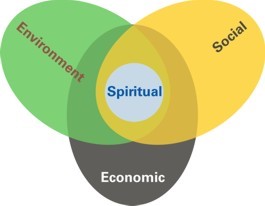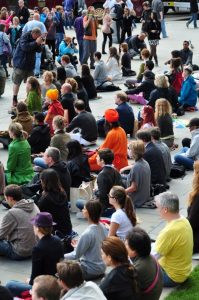By Sohail Inayatullah
UNESCO Chair in Futures Studies. Sinayatullah@gmail.com
At a socio-spiritual group gathering that advocates the adoption of Prout ideals, I had the chance to experiment with gaming and creating progressive policy futures by running the first Prout parliament game. The core question was what would the world look like if Prout – as theory and movement – was in power; if the core ideas of Prout were adopted as the norm, as informing and framing global and local legislative priorities?
It is considered by leading scholars as one of the clearest alternatives to capitalism (and communism).
The Prout parliament game has four parts. Part 1 is an explanation of core Prout ideas in a futures context. Part 2 is a futures wheel process that develops the implications of key emerging issues. Part 3 is the development of a checklist that is used to informed decision-making. And part 4 is the process of using the checklist to vote on parliamentary proposals. The structure and processes of the game lends itself to easy adoption for other social movements and organizations.
PART ONE
I began the workshop with the overall global context. First was Sri P.R. Sarkar’s argument that not only was time “galloping”, – increasing at a rapid pace – but that as global and local political and economic systems are experiencing flux, individuals can have a greater impact: you and I can make a difference. Second, the critical importance of vision, of defining where we as a society wished to be in 20 years. The argument made was that those who can imagine a desired future, feel the future they wish, had a greater chance of achieving the future. Strategy thus emerges from vision and not as an outcome of current problems. As Sarkar has argued: “What is the use of recollecting the history of your past life? Try to learn only about the future. You are to look ahead, you are to look forward. We must keep the goal fixed before us, and keep moving towards the goal.”
I then presented some critical aspects of Prout. These were:
a. Inclusive spiritual practice
b. A vegetarian diet, especially non-violence towards animals
c. Deep sustainability in that Gaia is treated as a cooperative partner
d. The switch to renewable energy and the creation of energy cooperatives through peer to peer energy platforms
e. Neo-humanistic education – a focus on teaching and telling stories that were based on planetary identity. Ethnicity, religion, nation-states are not defining: deep spirit and nature are. Traditional ethnic and gendered stereotypes are shunned for the stories of how humanity as a collective has solved problems.
f. The move toward regional association, imagining a confederation of Asian and antipodean states – an Asian-Australia union by 2038
G. Finally, we sought to remeasure this future, moving from GDP as defining to a quadruple bottom line: prosperity (increased goods and services), sustainability (nature, first), social inclusion (a society where inclusion is designed as the norm) and spirituality (happiness and other measures of bliss).

PART TWO
In this context, we developed six working groups and asked a series of what-if questions (derived from the foresight literature) for Australia by 2038. Each group explored the implications of each question and articulated Prout strategies.
- Chindia wins the current economic game – 50% of world GDP is produced by these two nations
- The neohumanist education revolution – national policy of teaching deep sustainability and inclusion.
- The energy shift to renewables – 50% of all homes produce their own energy
- Plant-based diets as the new normal – 50% of all individuals self-identify with a plant diet based (up from the current 1 million or 5% vegetarians or vegans in Australia)
- Gender equity – in 50% of all boards (up from the current 27-32%)
- Technologies of the mind – eight million practice meditation or 36% of the Australian population by 2038. This would be up from the current two million.
For the rise of Chindia, participants suggested that given the reality of conflict and war – as one hegemon was rising and another declining – developing pathways toward cooperation, through international mediation and arbitration in the Asian region was critical. More significantly, greater economic growth/equity would result if economic leaders China and India would move from the corporatist model to the platform cooperative model. They would not only succeed at the current economic game, but create a far more inclusive alternative game.
For the rise of plant based diets including the likely exponential growth of cellular agriculture, participants (who all happened to be between the ages of 8-14) suggested that Prout work with farmers to help them transition from meat based systems to plant based systems. Their suffering needed to be addressed. Prout practicing compassion was paramount here.[
The other groups adopted similar approaches focusing on spiritual education, housing for all, and health as primary. The gender group suggested there would need to be free or affordable education for women, including tertiary education. Moreover, gender would become far more fluid, and policies would reflect a cooperative worldview challenging the rigid roles of patriarchy. Moreover, what school children read and how they worked with each other would not be based on strict gender roles. Traditional feminine ways of knowing would not be marginalized in this alternative future.

The technologies of the mind group noted that with 50% of people meditating, there would likely be improved physical and mental health, thus freeing up financial resources to be used in other areas. There would also be an elevation of consciousness – softer, wiser, integrated – of the society, making progressive policy changes in other areas easier.
The energy group suggested that a renewables-based energy revolution would help mitigate climate change and help encourage local prosperity.

PART THREE
After brief presentations by each group, participants were asked to develop a Prout checklist. A checklist, developed by Peter Provost is meant to guide medical practitioners, ensuring that rules of safety and procedure are followed. These are step by step guidelines to ensure that sentiment does not come in the way of decision-making.
For the Prout movement, the checklist becomes a way of articulating policy based on the core Prout ideas and not on sentiments one may privately hold. It also helps in taking Prout from a theory to practice.
Groups articulated a number of salient points. Some of the key ones were:
- Does the policy lead to reduction in crime?
- Is the policy inclusive?
- Does the policy reduce pain to animals and nature?
- Does the policy encourage cooperation?
- Does the policy reduce inequity?
- Does the policy encourage cooperatives?
- Does the policy ensure that the basic requirements of housing, health, and education are provided for all?
- Does the policy benefit the majority of people?
- Can the outcomes of the policy be easily accessed by the majority of people?”
- Does the policy decentralize power?
- Does the policy help in creating regional governance?
- Does the policy wisely use new technologies?
As this was the first iteration of the game, they remained the working group level. In the future, I hope to develop this checklist into broader categories and develop a ranked list agreed upon by all participants.
PART FOUR
With the establishment of a working checklist, we then convened the Prout parliament. As this was experimental, we first had policy positions that were easy to dissect.
In the first, it was suggested that all western medicine be removed by 2038. Using the checklist, this was quickly voted down – as it excluded an important healing tradition, it would lead to more harm, and as one participant reminded, Sarkar was pluralistic toward healing tradition – what mattered most was whether the modality cured or not. The second policy suggestion was terminating funding for renewable energy sources and the move toward full nuclear.

This was also quickly voted down as the risk of harm was considered too great. Nuclearization would also lead to a concentration of economic power. Local, cooperative energy solutions from solar, wind, and geo-thermal were recommended, instead.
The parliamentary floor was then opened up to all proposals. Three individuals presented.
The first suggested that meditation practice be legislated for all high schools in Australia. There was a debate as to which type of meditation. This was clarified as 20 minutes a day of quiet mindfulness every morning. Further clarification was sought as to primary versus high schools. The presenter argued that for primary schools it would be optional, but for secondary schools, it would be mandatory. Given the health gains and correlated reduction in crime and other positives associated with mindfulness/meditation, the resolution was passed.

The second suggested that regulation for housing be reduced so that one could quickly put up homes as needed so as to reduce homelessness. The votes were positive, however, the gender group was concerned that a lack of regulation could adversely impact safety, nature, and cultural heritage. The presenter modified his proposal, asking for reduced regulation and not the end of regulation.
The last presenter wished to adopt a policy of no government interference in private education. Upon clarification that there would still be federal neohumanist guidelines, the proposal was passed. Education policy would be set through educational experts and registered bodies using evidence-base policy.
The game concluded with the parliament funding the three proposals. Each committee was given (an imaginary) one million dollars to fund research and implementation.
CONCLUSION
The conclusion was that the Prout Parliament game was
1. A practical and easy way to teach Prout
2.
A great way to envision what a Prout society could look like
3. An excellent approach – the checklist in particular – to shift Prout from grand theory and a possible future to pragmatic strategy. And:
4. Useful in enhancing negotiation and cooperation skills.
While some expressed positive doubt, the workshop ended with a quote from Sri Sarkar: “A bright future awaits you – your future is glorious, your future is luminous, your future is effulgent … the future of humanity is strikingly resplendent .


